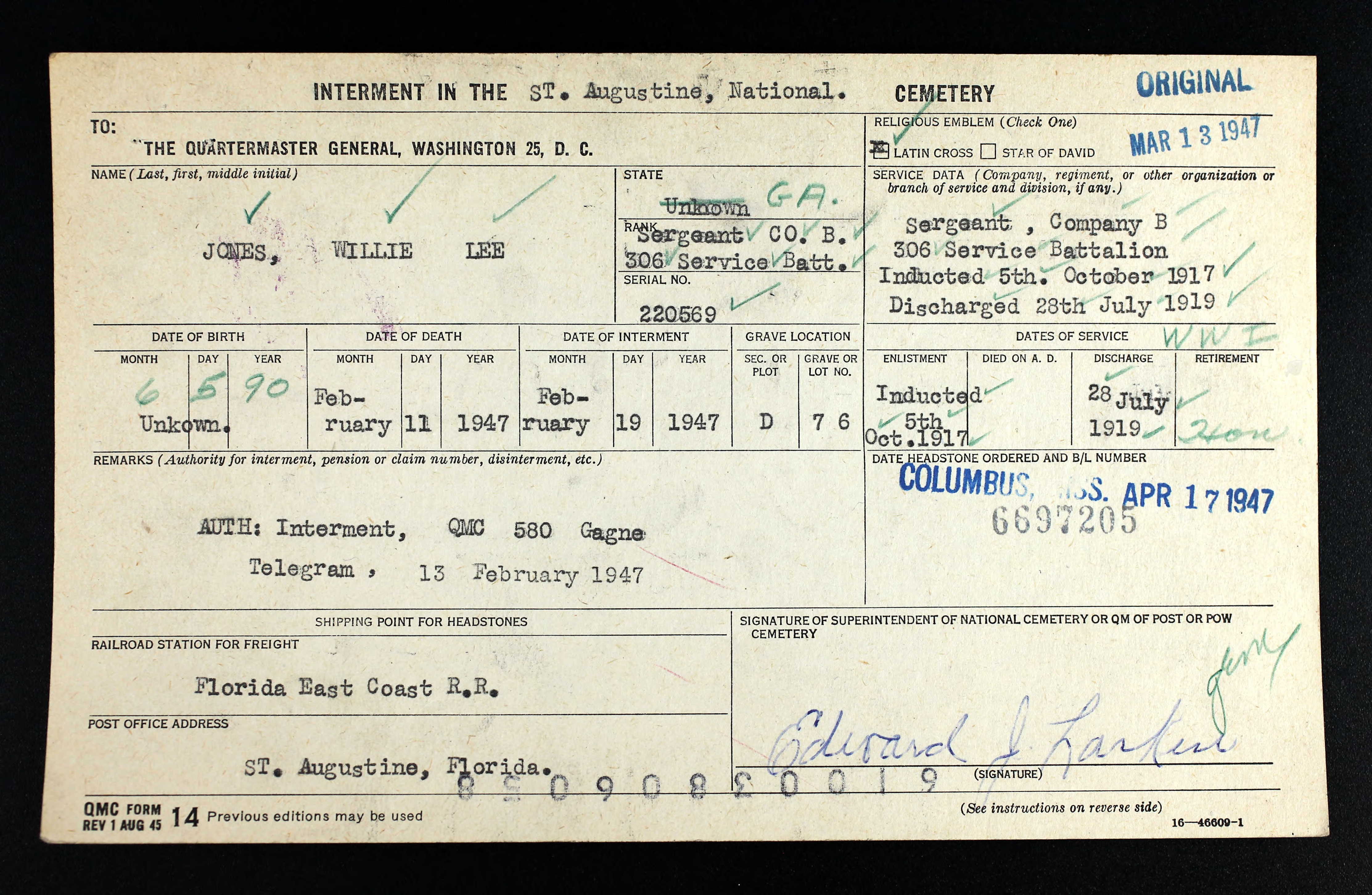Willie Lee Jones (June 5, 1890–February 11, 1947)
By Gramond McPherson
Early Life
Willie Lee Jones was born in Valdosta, Georgia, on June 5, 1890 where he lived until he joined the Army. As of 1917, Jones worked as a teamster for the city of Valdosta.1 Teamsters at the turn of the twentieth century drove wagons, either as passenger vehicles or for hauling items for delivery. While nationally, African Americans made up nearly thirteen percent of total teamsters, in Southern cities, blacks ranged from a quarter to over ninety percent of teamster workforce.2
Military Service
After the US entered World War I, the military needed to increase its manpower. Thus, Congress passed the Selective Service Act on May 18, 1917 requiring all men between the ages of twenty-one and thirty-one to register for the draft. On his twenty-seventh birthday on June 5, 1917, Jones registered for military service. On October 5, 1917, Jones was drafted into the Army. Nationally, the military drafted one-third of black registrants compared to one-fourth of white registrants.3 While many black soldiers may have hoped to serve in combat, most African Americans served in noncombatant units amid the Jim Crow era of enforced racial segregation. Whites, particularly Southerners, feared the consequences of blacks using their military experiences, such as firearm training, to initiate a racial war. Thus, the War Department sought to utilize blacks in non-threatening support roles ranging from motor transport to laundry, butchery to food preparation. As a result, after his basic training, Jones joined the 306th Labor Company, Company B, as shown here, as part of the Quartermaster Corps in the Army.4
On January 13, 1918, Jones and his unit embarked to France from the port in Hoboken, New Jersey. Jones lists his aunt, Sallie Jones Williams as his emergency contact back in Valdosta.5 After arriving in France, Jones received a promotion to sergeant on February 9, 1918. However on May 10, 1918, he was demoted back to the rank of private. Eventually he was re-appointed sergeant on July 1, 1918. While in France, Jones’ unit organized to form the 306th Service Battalion, which served as part of the Army’s Service of Supply (S.O.S.) units alongside the American Expeditionary Forces (AEF). While many black soldiers felt slighted in having to perform these duties and faced humiliation, mistreatment and outright brutality, Jones and other black soldiers contributed greatly to the overall war effort.6 Jones and his unit continued to serve overseas in France after the war ended, finally departing from Saint-Nazaire, France, on July 7, 1919. The 306th sailed back to the US aboard the USS Suwanee, as pictured here. After arriving at Camp Hill, Virginia, the unit demobilized. On July 28, 1919, the Army honorably discharged Jones.7
Post-Service Life
Jones was married to his wife Elnora. Jones died on February 11, 1947 and was interred at the St. Augustine National Cemetery on February 19, 1947 in Section D, Number 76.8
Endnotes
1 Jones’ draft registration card lists his birthplace as Americus, Georgia, while his service card lists Valdosta as his birthplace. “U.S. World War I Draft Registration Cards, 1917-1918,” database, Ancestry.com (http://ancestry.com : accessed July 12, 2018), entry for Willie Lee Jones; “Georgia, World War I Service Cards, 1917-1919,” database, Ancestry.com (https://ancestry.com : accessed July 12, 2018), entry for Willie Lee Jones.
2 David Witwer, “Race Relations in the Early Teamsters Union,” Labor History 43, no. 4 (November 1, 2002): 509-510, doi:10.1080/00236560220127194.
3 Jennifer D. Keene, World War I: The American Soldier Experience (Lincoln, NE: University of Nebraska Press, 2011), 33-37; “U.S. World War I Draft Registration Cards,” Ancestry.com, entry for Willie Lee Jones; “Georgia, World War I Service Cards,” Ancestry.com, Willie Lee Jones.
4 Keene, World War I, 95; Derrel B. Depasse, Traveling the Rainbow: The Life and Art of Joseph E. Yoakum (New York/Jackson, MS: Museum of American Folk Art/University Press of Mississippi, 2001), 11; Robert J. Dalessandro and Gerald Torrence, Willing Patriots: Men of Color in the First World War (Atglen, PA: Schiffer Publishing Ltd., 2009), 10; “Georgia, World War I Service Cards,” Ancestry.com, Willie Lee Jones.
5 “U.S. Army Transport Service, Passenger Lists, 1910-1939,” database, Ancestry.com (https://www.ancestry.com : accessed July 12, 2018), entry for Willie Lee Jones, January 18. 1918.
6 “Georgia, World War I Service Cards,” Ancestry.com, Willie Lee Jones; Keene, World War I, 95; Depasse, Traveling the Rainbow, 11; Dalessandro and Torrence, Willing Patriots, 10.
7 “U.S. Army Transport Service, Passenger Lists, 1910-1939,” database, Ancestry.com (https://www.ancestry.com : accessed July 12, 2018), entry for Willie Lee Jones, July 9, 1919; “Georgia, World War I Service Cards,” Ancestry.com, Willie Lee Jones; Dalessandro and Torrence, Willing Patriots, 33.
8 “U.S. Army Transport Service, Passenger Lists, 1910-1939,” database, Ancestry.com (https://www.ancestry.com : accessed July 12, 2018), entry for Willie Lee Jones, July 9, 1919; “U.S. National Cemetery Interment Control Forms,” Ancestry.com, Willie Lee Jones.
© 2018, University of Central Florida




